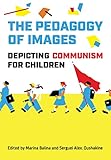The Pedagogy of Images : Depicting Communism for Children / ed. by Marina Balina, Serguei A. Oushakine.
Material type: TextSeries: Studies in Book and Print CulturePublisher: Toronto : University of Toronto Press, [2021]Copyright date: 2021Description: 1 online resource (568 p.) : 149 colour illustrations, 106 b&w illustrationsContent type:
TextSeries: Studies in Book and Print CulturePublisher: Toronto : University of Toronto Press, [2021]Copyright date: 2021Description: 1 online resource (568 p.) : 149 colour illustrations, 106 b&w illustrationsContent type: - 9781487506681
- 9781487534653
- Avant-garde (Aesthetics) -- Soviet Union
- Children's literature, Soviet -- History and criticism
- Communism in literature
- Education -- Political aspects -- Soviet Union
- Illustrated children's books -- Soviet Union
- Literacy -- Political aspects -- Soviet Union
- Propaganda, Soviet
- LITERARY CRITICISM / Books & Reading
- Communism
- Lenin
- Russian Revolution
- Socialist realism
- Soviet Union
- Soviet literature for children
- Soviet
- children’s literature
- mass culture
- modernity
- pedagogy
- propaganda
- visual language
- 891.709/9282 23
- online - DeGruyter
| Item type | Current library | Call number | URL | Status | Notes | Barcode | |
|---|---|---|---|---|---|---|---|
 eBook
eBook
|
Biblioteca "Angelicum" Pont. Univ. S.Tommaso d'Aquino Nuvola online | online - DeGruyter (Browse shelf(Opens below)) | Online access | Not for loan (Accesso limitato) | Accesso per gli utenti autorizzati / Access for authorized users | (dgr)9781487534653 |
Frontmatter -- Contents -- Illustrations -- Acknowledgments -- Introduction Primers in Soviet Modernity: Depicting Communism for Children in Early Soviet Russia 3 -- PART I MEDIATION -- Chapter one THREE DEGREES OF EXEMPLARY BOYHOOD IN BORIS KUSTODIEV’S SOVIET PARADISE -- Chapter two HOW THE REVOLUTION TRIUMPHED: ALISA PORET’S TEXTBOOK OF CULTURAL ICONOGRAPH -- Chapter three “FOTO-GLAZ”: CHILDREN AS PHOTO-CORRESPONDENTS IN EARLY SOVIET PIONEER MAGAZINES -- Chapter four AUTONOMOUS ANIMALS ANIMATED: SAMOZVERI AS A CONSTRUCTIVIST PEDAGOGICAL CINE-DISPOSITIVE -- Chapter five THE FRAGILE POWER OF PAPER AND PROJECTIONS -- PART II TECHNOLOGY -- Chapter six FROM NATURE TO “SECOND NATURE” AND BACK -- Chapter seven AUTONOMY AND THE AUTOMATON: THE CHILD AS INSTRUMENT OF FUTURITY -- Chapter eight SPELLS OF MATERIALIST MAGIC, OR SOVIET CHILDREN AND ELECTRIC POWER -- Chapter nine “DO IT ALL YOURSELF!” TEACHING TECHNOLOGICAL CREATIVITY DURING SOVIET INDUSTRIALIZATION -- Chapter ten THE CAMEL AND THE CABOOSE: VIKTOR SHKLOVSKY’S TURKSIB AND THE PEDAGOGY OF UNEVEN DEVELOPMENT -- Chapter eleven AEROPLANE, AEROBOAT, AEROSLEIGH: PROPELLING EVERYWHERE IN SOVIET TRANSPORTATION -- PART III POWER -- Chapter twelve SPATIALIZING REVOLUTIONARY TEMPORALITY: FROM MONTAGE AND DYNAMISM TO MAP AND PLAN -- Chapter thirteen “POOR, POOR IL’ICH”: VISUALIZING LENIN’S DEATH FOR CHILDREN -- Chapter Fourteen YOUNG SOLDIERS AT PLAY: THE RED ARMY SOLDIER AS ICON -- Chapter fifteen THE WORKING BODY AND ITS PROSTHESES: IMAGINING CLASS FOR SOVIET CHILDREN -- Chapter sixteen AMERIKANIZM: THE BRAVE NEW NEW WORLD OF SOVIET CIVILIZATION -- Illustration Credits -- Contributors -- Index
restricted access online access with authorization star
http://purl.org/coar/access_right/c_16ec
In the 1920s, with the end of the revolution, the Soviet government began investing resources and energy into creating a new type of book for the first generation of young Soviet readers. In a sense, these early books for children were the ABCs of Soviet modernity; creatively illustrated and intricately designed, they were manuals and primers that helped the young reader enter the field of politics through literature. Children’s books provided the basic vocabulary and grammar for understanding new, post-revolutionary realities, but they also taught young readers how to perceive modern events and communist practices. Relying on a process of dual-media rendering, illustrated books presented propaganda as a simple, repeatable narrative or verse, while also casting it in easily recognizable graphic images. A vehicle of ideology, object of affection, and product of labour all in one, the illustrated book for the young Soviet reader emerged as an important cultural phenomenon. Communist in its content, it was often avant-gardist in its form. Spotlighting three thematic threads – communist goals, pedagogy, and propaganda – The Pedagogy of Images traces the formation of a mass-modern readership through the creation of the communist-inflected visual and narrative conventions that these early readers were meant to appropriate.
Mode of access: Internet via World Wide Web.
In English.
Description based on online resource; title from PDF title page (publisher's Web site, viewed 19. Oct 2024)


